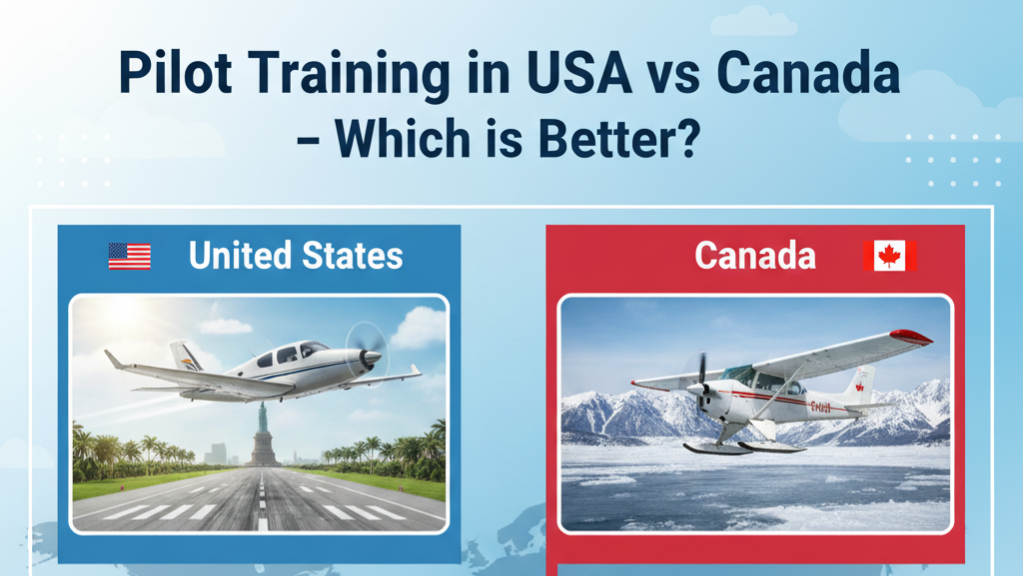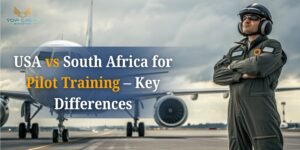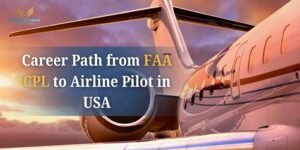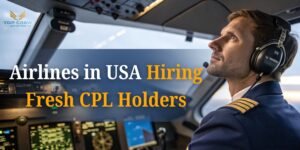If you dream of becoming a pilot and flying across the world, you’ve probably wondered — where should I train? Among the most popular choices, pilot training in the USA and pilot training in Canada top the list for thousands of international students every year.
Both countries offer world-class aviation programs, advanced aircraft fleets, and global recognition. But when you start comparing the cost of pilot training in USA vs Canada, licensing systems, or even weather conditions, the decision becomes tricky.
Should you go for the FAA pilot license in the United States with its fast-paced programs and flexible structure? Or should you choose the Transport Canada pilot license, known for its disciplined approach and balanced costs?
This guide is here to help you make that decision — confidently.
We’ll break down everything you need to know about pilot training USA vs Canada — from course structures, costs, and training systems to career opportunities and lifestyle factors.
By the end, you’ll have a clear idea of which country suits your goals, budget, and timeline best.
So, let’s take off into the details and help you find out — is the USA or Canada truly the best country for pilot training?
Pilot Training Overview in North America
North America has long been considered the global hub of aviation training. Both the USA and Canada have well-established aviation education systems backed by decades of safety, innovation, and experience.
In both countries, aspiring pilots can start with a Private Pilot License (PPL), progress to an Instrument Rating (IR), and then complete a Commercial Pilot License (CPL) — the qualification needed to fly professionally.
However, the training environments differ. The United States offers flexibility with its FAA-approved flight schools, while Canada, under Transport Canada, follows a more structured and regulated approach.
Here’s a quick snapshot:
- USA: Shorter training duration, ideal weather for flying year-round, and globally recognized FAA license.
- Canada: High-quality instruction, cost-effective programs, and exposure to challenging weather — great for skill development.
Both systems are respected worldwide, and both allow license conversions if you plan to work elsewhere later.
Whether you plan to train under sunny skies in Florida or snowy conditions in Toronto, pilot training USA vs Canada ultimately depends on your career ambitions, finances, and preferred training environment.
Pilot Training in the USA – System, Costs, and Advantages
The United States is the world’s most popular destination for pilot training. Its aviation system, governed by the Federal Aviation Administration (FAA), is globally respected for its flexibility, efficiency, and technology-driven training standards.
Training System:
You can start with a Private Pilot License (PPL), move to Instrument Rating (IR), and then complete your Commercial Pilot License (CPL). Some students also pursue Certified Flight Instructor (CFI) ratings to build flight hours.
Duration:
Typically, pilot training in the USA takes 12–18 months — faster than in most countries due to consistent weather and abundant flying days.
Cost of Pilot Training in USA:
Expect to spend around $70,000–$90,000 USD (approximately ₹58–₹75 lakhs), including ground school, flight hours, and living expenses.
Advantages:
- Over 5,000 FAA-approved flight schools to choose from.
- Flexible, modular courses — learn at your own pace.
- Year-round good weather in states like Florida, Texas, and California.
- Global recognition of the FAA pilot license.
- Opportunities to work as a CFI and build hours.
The USA’s diverse flying conditions and advanced simulator access give students real-world experience early on.
If you’re looking for speed, flexibility, and international recognition, pilot training in USA is hard to beat.
Pilot Training in Canada – System, Costs, and Advantages
Pilot training in Canada offers a structured and disciplined pathway under Transport Canada (TC). Canadian flight schools are known for quality instruction, safety culture, and cost efficiency.
Training System:
The journey starts with a Private Pilot License (PPL), followed by Night Rating, Instrument Rating (IR), and finally, Commercial Pilot License (CPL). Many students also pursue Multi-Engine Ratings and Instructor Ratings after CPL.
Duration:
Training typically takes 18–24 months, slightly longer than in the USA due to weather conditions and regulatory requirements.
Cost of Pilot Training in Canada:
Expect to spend CAD 70,000–90,000 (₹45–₹55 lakhs), including accommodation and living costs — generally lower than the USA.
Advantages:
- Globally recognized Transport Canada pilot license.
- Exposure to diverse and challenging weather — builds strong flying skills.
- High safety and maintenance standards.
- Easier immigration options for international students post-training.
- Training quality often rated among the world’s best.
Canada’s weather diversity (snow, fog, low visibility) enhances pilot adaptability — an advantage when flying for airlines later.
For students seeking affordable, high-quality commercial pilot training, Canada stands out as one of the best countries for pilot training.
FAA vs Transport Canada Licensing – Key Differences
When comparing pilot training USA vs Canada, one major difference lies in licensing.
In the USA:
The FAA (Federal Aviation Administration) issues licenses like:
- Private Pilot License (PPL)
- Instrument Rating (IR)
- Commercial Pilot License (CPL)
- Certified Flight Instructor (CFI)
The FAA system is modular and internationally recognized. Many airlines worldwide accept FAA licenses, though local conversion may be required.
In Canada:
Transport Canada (TC) issues equivalent licenses:
- PPL (Private Pilot License)
- CPL (Commercial Pilot License)
- IR (Instrument Rating)
- ATPL (Airline Transport Pilot License)
While both systems have similar structures, Transport Canada places more emphasis on meteorology, navigation, and flight experience in variable conditions.
If you plan to work in India later, both licenses can be converted to DGCA pilot licenses after passing required DGCA exams.
In short:
- FAA license: Fast, flexible, globally recognized.
- Transport Canada license: Structured, respected, and builds strong all-weather skills.
Cost, Living Expenses & Training Quality
The cost of pilot training in USA vs Canada is one of the biggest deciding factors. Here’s a comparison:
| Category | USA (FAA) | Canada (Transport Canada) |
|---|---|---|
| Training Cost | $70,000–$90,000 USD | CAD 70,000–90,000 |
| Living Expenses | $1,200–$1,800/month | CAD 1,000–1,400/month |
| Duration | 12–18 months | 18–24 months |
| Weather | Mostly clear | More variable |
| License Recognition | Global | Global |
| Job Opportunities | Excellent | Excellent + immigration-friendly |
In the USA, training can be faster because of favorable flying weather and a large number of aircraft and instructors. However, living costs may be higher in major cities.
In Canada, though training may take longer due to weather delays, you’ll often save on living expenses and tuition. Canadian schools are known for producing resilient pilots due to tougher conditions.
Both countries provide top-tier flight safety, advanced simulators, and globally valid training standards.
When evaluating cost, also factor in visa duration, living location, and post-training employment options.
Career Prospects and Job Opportunities
After completing commercial pilot training USA or Canada, many students look to build flight hours and gain work experience.
In the USA:
FAA graduates can apply for a CFI (Certified Flight Instructor) rating to teach and log flight hours — a common path to reach the 1,500-hour requirement for airline jobs. The U.S. job market is strong, with regional airlines and charter services often hiring FAA-certified pilots.
In Canada:
Transport Canada allows qualified graduates to work as Flight Instructors or in bush flying, aerial survey, or charter roles. Moreover, Canada’s Post-Graduation Work Permit (PGWP) policy allows students to stay and work for up to three years after completing training — a huge advantage for international students.
Both countries provide excellent job prospects, but Canada is often favored by those seeking permanent residency opportunities alongside aviation careers.
In the long run, both FAA and Transport Canada licenses can be converted to DGCA, EASA, or other regional authorities, keeping your global career options open.
Step-by-Step Guide to Choosing Between USA and Canada
Here’s a simple checklist to help you decide:
- Set Your Goal – Do you plan to work in North America or return to India?
- Compare Costs – Include training fees, living, visa, and conversion expenses.
- Evaluate Duration – The USA is faster; Canada is more structured.
- Check School Accreditation – Ensure it’s FAA- or TC-approved.
- Consider Weather Conditions – Prefer consistent (USA) or varied (Canada) weather?
- Plan for Work Options – Canada offers better post-study work permits.
- Check Conversion Process – Understand DGCA license conversion steps if needed.
If you value speed, flexibility, and global exposure — pilot training in USA may suit you.
If you prefer structured learning, affordability, and immigration options — pilot training in Canada could be your best path.
Either way, both countries offer world-class aviation education and career growth.
Conclusion
Choosing between pilot training in USA vs Canada is an exciting yet crucial step toward your aviation dream.
Both nations offer excellent Pilot training quality, internationally recognized licenses, and strong aviation ecosystems. The difference lies in training pace, cost, lifestyle, and post-training opportunities.
The USA offers speed, flexibility, and sunshine — ideal for those who want to finish training quickly and start working sooner. The Canada route provides structured learning, affordable options, and long-term career pathways through work permits and PR options.
Your decision should match your career goals, financial capacity, and preferred living environment.
Whether it’s the FAA in the U.S. or Transport Canada in the North, both routes lead to the same destination — your cockpit career!
Ready to take off? Start by shortlisting top flight schools in your preferred country and take the first step toward becoming a commercial pilot today. The skies are waiting!



